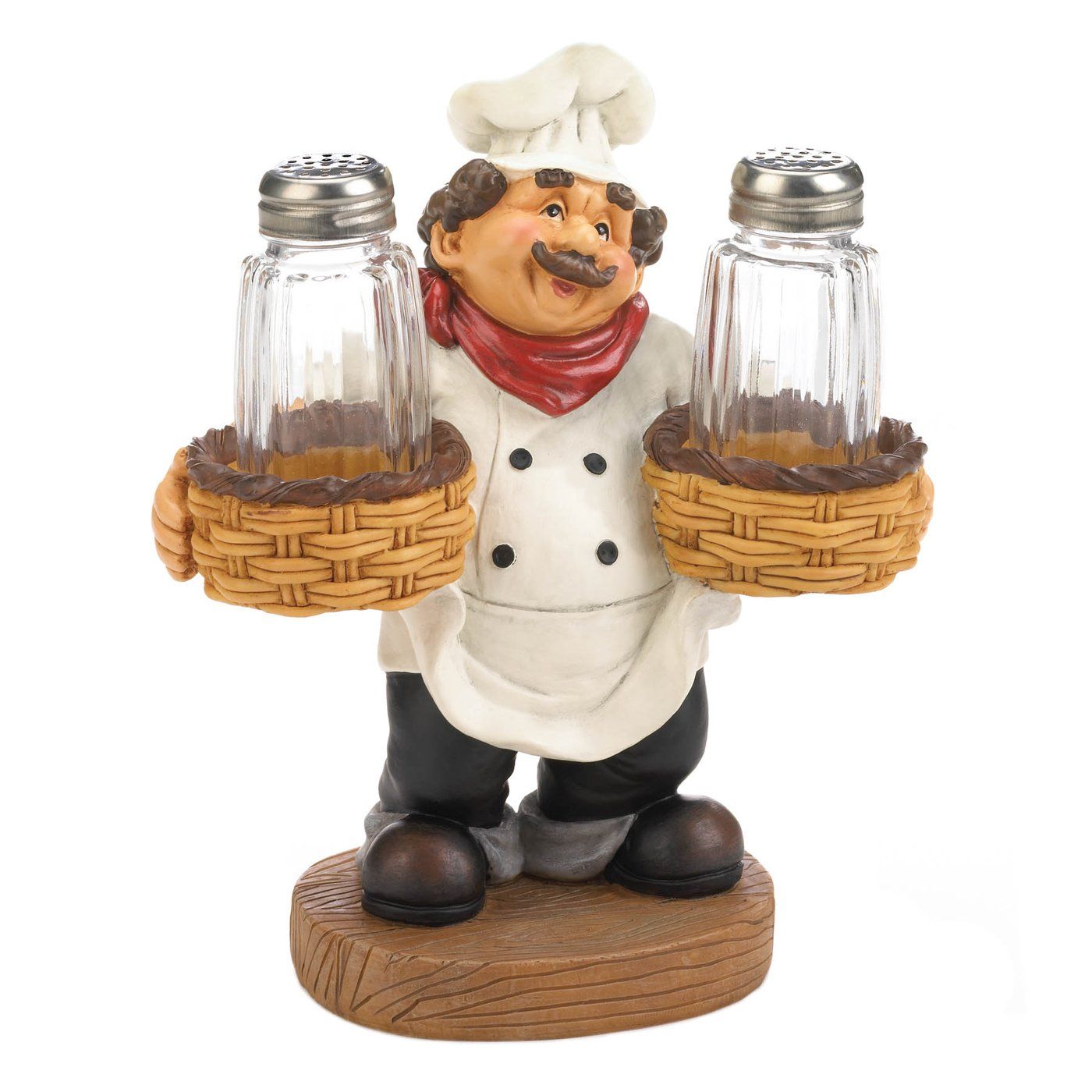Home>Dining>Tableware>Why Do Some Restaurants Not Have Salt And Pepper Shakers?


Tableware
Why Do Some Restaurants Not Have Salt And Pepper Shakers?
Modified: January 2, 2024
Discover why certain restaurants forgo the traditional use of salt and pepper shakers in their tableware, exploring the intriguing reasons behind this interesting dining practice.
(Many of the links in this article redirect to a specific reviewed product. Your purchase of these products through affiliate links helps to generate commission for Storables.com, at no extra cost. Learn more)
Introduction
When we sit down at a restaurant table, we often expect to find a familiar sight – salt and pepper shakers. These small condiment holders have become a staple in the dining experience, allowing us to season our food to our liking. However, have you ever come across a restaurant where the tableware is noticeably missing this ubiquitous duo? You may wonder why some restaurants choose not to provide salt and pepper shakers to their patrons.
In this article, we will shed some light on this intriguing phenomenon and explore the reasons behind it. From culinary expertise to cost considerations, there are several factors that influence a restaurant’s decision to withhold salt and pepper shakers. So, let’s delve into the world of tableware and discover why some restaurants opt for a salt and pepper-free dining experience.
Key Takeaways:
- Restaurants omit salt and pepper shakers to showcase culinary expertise, preserve unique flavor profiles, and ensure quality assurance. This deliberate choice highlights the dedication to crafting memorable dining experiences and honoring cultural traditions.
- The absence of salt and pepper shakers reflects chefs’ artistic vision, minimalistic dining aesthetics, and practical considerations. It emphasizes the immersive gastronomic journey, personalized service, and commitment to dietary inclusivity.
Reasons for not having salt and pepper shakers
While it may seem counterintuitive for a restaurant not to provide salt and pepper shakers, there are legitimate reasons behind this decision. Let’s explore some of the most common reasons:
-
Culinary Expertise
One possible reason is that the chefs and kitchen staff have meticulously crafted the dishes to perfection. They have carefully balanced the flavors and seasoning to create a harmonious culinary experience. By omitting salt and pepper shakers, the restaurant aims to ensure that diners enjoy the dish as intended, without the risk of over or under seasoning.
-
Unique Flavor Profiles
Another reason could be that the restaurant specializes in unique flavor profiles or offers regional or international cuisine. Each dish is infused with specific herbs, spices, and seasonings that are carefully selected to bring out the traditional tastes of that particular cuisine. The absence of salt and pepper shakers encourages diners to experience the authentic flavors without diluting or altering them.
-
Quality Assurance
Restaurants that prioritize quality assurance may choose to eliminate salt and pepper shakers to maintain consistent taste across all dishes. By having the chefs control the seasoning process, the restaurant can ensure that every plate leaving the kitchen meets their high standards. This approach helps to establish a reputation for delivering exceptional dining experiences.
-
Chef’s Vision
Some restaurants are driven by the vision and creativity of their chefs. These culinary artists aim to present their dishes as complete works of art, carefully constructed with flavor profiles that tell a story. By not providing salt and pepper shakers, the chef invites diners to trust their expertise and fully immerse themselves in the gastronomic journey the chef has curated.
-
Simplicity and Minimalism
Many modern restaurants embrace a minimalist approach to dining, focusing on clean lines, uncluttered spaces, and streamlined experiences. Omitting salt and pepper shakers aligns with this aesthetic, creating a visually appealing table setting. It also promotes interaction with the waitstaff, who can provide personalized recommendations or adjustments to suit individual tastes.
-
Cost and Maintenance
Salt and pepper shakers require regular refilling, cleaning, and maintenance. By removing them from the table, restaurants can streamline their operations and reduce costs associated with maintaining these additional condiments. This allows them to allocate resources towards other aspects of the dining experience, such as fresh ingredients or unique presentation methods.
-
Dietary Restrictions
Restaurants that cater to specific dietary restrictions or health-conscious individuals may opt to exclude salt and pepper shakers. This approach ensures that dishes are prepared with restricted sodium levels or specific seasonings that align with the dietary requirements of certain patrons. It also helps to prevent inadvertent cross-contamination or mixing of ingredients.
-
Read more: How To Wash Metal Salt And Pepper Shakers
Regional or Cultural Factors
In certain regions or cultures, it is customary to enjoy food as it is presented, without additional seasoning. Restaurants that aim to provide an authentic cultural experience may choose to omit salt and pepper shakers to respect these traditions and showcase the purity of their culinary heritage.
These reasons highlight the diverse motivations behind restaurants’ decision not to have salt and pepper shakers on their tables. Whether it’s to maintain the integrity of flavors, adhere to their chef’s vision, or cater to specific dietary needs, each restaurant has its unique considerations in creating a memorable dining experience.
Culinary Expertise
One of the primary reasons why some restaurants choose not to have salt and pepper shakers is due to their culinary expertise. These establishments pride themselves on their ability to carefully craft and balance the flavors in each dish they serve.
By omitting salt and pepper shakers, the chefs and kitchen staff retain full control over the seasoning process. They have spent years honing their skills and developing recipes that rely on precise measurements and intricate flavor combinations. They believe that the dishes they present to their patrons are already perfectly seasoned and do not require any additional seasoning at the table.
This approach ensures that diners experience each dish as intended, without the risk of overpowering or diluting the flavors. The chefs have taken into consideration various factors such as the ingredients used, cooking techniques, and the desired taste profile of the dish. They aim to create a harmonious balance of flavors that complement and enhance one another.
For these restaurants, omitting salt and pepper shakers is a way to showcase their culinary expertise and present their dishes as complete culinary works of art. They want diners to trust their skills and allow the flavors crafted by their experienced chefs to shine through.
In some cases, chefs may even incorporate unique seasoning techniques or ingredients that deviate from traditional salt and pepper. By removing salt and pepper shakers from the table, they encourage diners to appreciate and savor the distinctive flavors that their culinary creations offer.
However, it’s important to note that restaurants that prioritize culinary expertise still prioritize customer satisfaction. In the absence of salt and pepper shakers, they usually train their staff to address any specific seasoning preferences or requests from diners. This allows for a personalized dining experience where the waitstaff can make adjustments to accommodate individual tastes, ensuring that each diner enjoys their meal to the fullest.
Unique Flavor Profiles
Another reason why some restaurants choose not to have salt and pepper shakers is the desire to highlight the unique flavor profiles of their dishes. These establishments specialize in specific cuisines or offer regional and international fare, where distinct flavors and seasonings play a crucial role.
By omitting salt and pepper shakers, these restaurants aim to preserve the integrity of their flavor profiles and ensure that diners experience the authentic taste of their dishes. Each dish is carefully crafted with a combination of herbs, spices, and seasonings that are essential to the culinary traditions they represent.
For example, a restaurant specializing in traditional Thai cuisine may use a blend of lemongrass, Thai chilies, and aromatic herbs to create a delicate balance of sweet, spicy, and tangy flavors. Adding salt and pepper at the table may alter this delicate balance and diminish the authenticity of the dish. By omitting salt and pepper shakers, the restaurant encourages diners to appreciate and savor the intricate flavors that define Thai cuisine.
Similarly, restaurants offering regional or international dishes strive to capture the essence of a particular cuisine. By removing the option of additional seasoning, they ensure that diners experience the dishes as they would in the country of origin.
This approach also allows restaurants to showcase the diversity and complexity of flavor profiles. It prompts diners to explore and appreciate the richness and nuances of different cuisines, beyond just the basic taste of salt and pepper. It can be an eye-opening experience that expands one’s culinary horizons and deepens their appreciation for the art of gastronomy.
However, it’s important to note that the absence of salt and pepper shakers doesn’t imply that these dishes are lacking in flavor. On the contrary, these restaurants pride themselves on creating dishes that burst with vibrant flavors and take diners on a culinary adventure. Each bite is meant to be a journey through the carefully selected flavors and ingredients that make up the dish.
Overall, by omitting salt and pepper shakers, restaurants with unique flavor profiles aim to offer an immersive dining experience that showcases the exquisite tastes and cultural heritage of their cuisine.
Quality Assurance
Restaurants that prioritize quality assurance often choose not to have salt and pepper shakers on their tables. Their primary goal is to ensure consistency in taste and deliver a high-quality dining experience to every customer.
By eliminating the option for guests to add their own seasoning, these restaurants can maintain control over the flavor profiles of their dishes. The chefs meticulously craft each dish, ensuring that the seasonings are perfectly balanced and complement the ingredients and cooking techniques used.
With salt and pepper shakers absent from the table, the responsibility of seasoning falls solely on the chefs and kitchen staff. This allows them to maintain strict standards and ensure that each plate leaving the kitchen matches the restaurant’s exacting specifications.
Consistency is crucial for these restaurants to establish a reputation for delivering exceptional dining experiences. By having full control over the seasoning process, they can guarantee that every dish tastes the same regardless of when it is prepared or who prepares it.
Quality assurance also extends to the use of fresh ingredients and rigorous recipe execution. These restaurants invest significant time and effort in sourcing the finest produce and carefully selecting spices and seasonings. Omitting salt and pepper shakers helps to preserve the integrity of the dishes and prevent any accidental deviations from the intended flavor profile.
Additionally, the absence of salt and pepper shakers prevents diners from potentially over-seasoning their food. Some people have a tendency to rely heavily on salt and pepper to compensate for perceived lack of flavor in a dish. By removing these condiments, the restaurant encourages diners to appreciate the true flavors of the dish without the need for excessive seasoning.
Overall, quality assurance is a driving factor behind the decision not to have salt and pepper shakers. These restaurants prioritize consistency, meticulous seasoning, and the use of premium ingredients to ensure that every dish meets their high standards of excellence.
Chef’s Vision
One compelling reason why some restaurants choose not to have salt and pepper shakers on their tables is to align with the chef’s vision. Many chefs consider their culinary creations as works of art, and each dish tells a unique story through its flavors and presentation.
By excluding salt and pepper shakers, chefs invite diners to experience their dishes as a cohesive and complete culinary masterpiece. They have meticulously crafted the menu, taking into consideration the flavor profiles, ingredient combinations, and cooking techniques that best showcase their vision.
Seasoning plays a vital role in this artistic process. Chefs carefully measure and balance the spices, herbs, and other seasonings to achieve the desired taste and presentation. They want diners to experience the dish exactly as they intended without any potential alterations caused by additional seasoning at the table.
By removing salt and pepper shakers, chefs encourage diners to trust their expertise and appreciate the flavors and textures they have carefully orchestrated. It also creates an opportunity for diners to explore new and unfamiliar taste sensations, allowing for a more adventurous and immersive dining experience.
For some chefs, seasoning is an integral part of the storytelling process. Each dish has a narrative embedded within, and the chef wants the flavors to unfold naturally to carry that story to the diner’s palate. Additional seasoning can disrupt this carefully constructed journey and dilute the intended impact.
Furthermore, chefs often incorporate unique and unconventional seasonings that deviate from traditional salt and pepper. The absence of salt and pepper shakers encourages diners to focus on these distinctive flavor combinations and create a memorable dining experience.
It’s important to note that, despite the absence of salt and pepper shakers, chefs and restaurants still prioritize customer satisfaction. Waitstaff is trained to address any specific seasoning preferences or requests from diners. This ensures that the chef’s vision is upheld while still providing flexibility to cater to individual tastes when necessary.
Overall, by omitting salt and pepper shakers from the table, restaurants embrace the chef’s vision and allow diners to immerse themselves in a culinary adventure guided by the chef’s creative mastery.
Simplicity and Minimalism
Simplicity and minimalism are key elements of modern dining experiences, and some restaurants choose not to have salt and pepper shakers on their tables to align with this aesthetic. These establishments aim to create a visually appealing and uncluttered dining environment that emphasizes the food and the overall dining experience.
By removing salt and pepper shakers, the table setting appears clean and streamlined. The absence of these condiments eliminates visual distractions, allowing the focus to remain on the beautifully presented dishes and the ambiance of the restaurant.
Additionally, restaurants that prioritize simplicity and minimalism often seek to foster a more interactive relationship between diners and the waitstaff. By omitting salt and pepper shakers, the role of the waitstaff becomes crucial in providing personalized recommendations and accommodating any specific seasoning preferences or adjustments that diners may have.
This interaction promotes a more engaging and tailored dining experience. The waitstaff becomes a knowledgeable guide, who can offer insights and suggestions that enhance the overall enjoyment of the meal.
Beyond aesthetics and engagement, the absence of salt and pepper shakers also encourages diners to trust the expertise and creativity of the chefs. Each dish is carefully prepared to deliver a specific flavor profile, and the chefs want diners to experience the intended taste without the need for additional seasoning.
Simplicity and minimalism are not just about the visual aspects of the dining experience. They also extend to the concept of focusing on essential flavors and letting the ingredients speak for themselves. By removing salt and pepper shakers, restaurants encourage diners to savor the true flavors and nuances of the dishes, appreciating the natural qualities of the ingredients and the culinary mastery behind each creation.
Overall, the decision not to have salt and pepper shakers on the tables is driven by a desire to create a visually appealing, uncluttered atmosphere that emphasizes simplicity and minimalism. It promotes engagement with the waitstaff and encourages diners to trust and appreciate the flavors and expertise of the chefs.
Cost and Maintenance
Cost and maintenance considerations are practical factors that influence some restaurants’ decision not to have salt and pepper shakers on their tables. While seemingly small, these condiments require ongoing expenses and effort to ensure their availability and proper maintenance.
Firstly, the cost of providing salt and pepper shakers can add up over time, especially for high-volume restaurants. These establishments often need to constantly replenish the condiments to meet the demands of their customers. By eliminating salt and pepper shakers, restaurants can allocate those resources to other aspects of the dining experience, like sourcing high-quality ingredients or investing in innovative cooking techniques.
In addition to the upfront costs, there are ongoing maintenance expenses associated with salt and pepper shakers. They need regular refilling, cleaning, and occasional replacements when damaged or lost. By not having them on the tables, restaurants can simplify their operations and reduce the workload and expenses associated with maintaining these additional items.
Moreover, the absence of salt and pepper shakers reduces the risk of condiments being spilled, wasted, or misused by diners. This saves not only on the cost of the condiments themselves but also on the potential impact on the overall dining experience.
Without the need for salt and pepper shakers, the focus can shift towards other aspects of the dining experience that contribute to guest satisfaction. Restaurants can invest more in staff training, creating a welcoming environment, or offering unique menu items that differentiate them from their competitors.
Additionally, the elimination of salt and pepper shakers allows restaurants to streamline their table settings and create a more cohesive aesthetic. It aligns with the minimalist and modern design trends that many eateries strive for, providing a visually appealing dining experience that focuses on the food and the ambiance.
Overall, the decision not to provide salt and pepper shakers on tables is driven by practical considerations of cost and maintenance. By freeing up resources and simplifying operations, restaurants can redirect their efforts towards enhancing other aspects of the dining experience, ultimately benefiting both the business and its patrons.
Dietary Restrictions
Restaurants that cater to specific dietary restrictions or health-conscious individuals often choose not to have salt and pepper shakers on their tables. This approach ensures that the dishes they serve adhere to the dietary requirements of their patrons.
For individuals with specific health conditions, such as high blood pressure or heart disease, reducing sodium intake is crucial. By eliminating salt and pepper shakers, these restaurants can control the sodium levels in their dishes, ensuring they meet the dietary guidelines for their target audience.
Furthermore, some people may have allergies or sensitivities to certain ingredients commonly found in seasoning blends. By not having salt and pepper shakers, the restaurant can guarantee that their dishes are free from potential allergens or irritants, providing a safe dining experience for individuals with dietary restrictions.
Restaurants that focus on specific dietary regimes, such as vegan, gluten-free, or paleo diets, carefully select their ingredients and seasonings to align with these requirements. Omitting salt and pepper shakers ensures that the dishes are prepared with the approved seasonings and eliminates the risk of cross-contamination or accidental mixing of ingredients that may occur with shared condiments.
The absence of salt and pepper shakers also prompts patrons with dietary restrictions to communicate their needs directly with the waitstaff. This allows the restaurant to provide a more personalized dining experience by accommodating specific seasoning preferences or offering alternative seasonings that adhere to the individual’s dietary restrictions.
By catering to dietary restrictions and offering dishes that meet specific requirements, restaurants create a safe and inclusive environment for those with unique dietary needs. They demonstrate their commitment to providing options that align with various health considerations, allowing patrons to enjoy a meal with peace of mind.
Overall, the decision not to provide salt and pepper shakers is driven by the desire to cater to individuals with dietary restrictions or specific health requirements. It ensures that the dishes served meet the necessary dietary guidelines, providing a safe and enjoyable dining experience for all.
Read more: How To Decorate Salt And Pepper Shakers
Regional or Cultural Factors
Regional or cultural factors play a significant role in why some restaurants choose not to have salt and pepper shakers on their tables. Culinary traditions and customs vary around the world, and these establishments aim to provide an authentic dining experience that respects and showcases the flavors and practices of a particular region or culture.
In certain cultures or regions, it is customary to enjoy food as it is served, without additional seasoning. The chefs and restaurateurs believe that the dishes they present to their patrons are already perfectly balanced in terms of flavors and seasonings. By omitting salt and pepper shakers, they encourage diners to savor the authentic taste of the cuisine without diluting or altering it.
These restaurants take pride in representing the culinary heritage of a specific region or culture. They meticulously select ingredients and seasonings that are essential to the authenticity of their dishes. By omitting salt and pepper shakers, they preserve the purity of these traditional flavors and maintain the integrity of the culinary traditions they represent.
In some cases, the decision not to have salt and pepper shakers is also influenced by cultural symbolism. Each dish may have its own symbolic meaning or significance within the cultural context. Additional seasoning at the table may be seen as a sign of disrespect to the chef’s skills or an indication that the dish is not flavorful enough on its own.
These establishments aim to create a dining experience that transports diners to the region or culture they represent. By omitting salt and pepper shakers, they help create a sense of immersion and authenticity, allowing diners to fully appreciate the unique flavors and culinary traditions associated with that particular cuisine.
By showcasing the culinary heritage of a specific region or culture, these restaurants also educate their diners about the richness and diversity of global cuisines. Diners have the opportunity to expand their culinary horizons and develop a deeper appreciation for the cultural significance of dishes and ingredients.
Overall, the decision not to provide salt and pepper shakers is driven by the desire to honor and preserve the regional or cultural traditions associated with the cuisine. It allows restaurants to create an authentic dining experience that transports diners to a specific time and place, while also fostering cross-cultural understanding and appreciation.
Some restaurants may not have salt and pepper shakers due to health and safety regulations, as individual packets or disposable shakers are considered more hygienic.
Conclusion
The absence of salt and pepper shakers in some restaurants may initially surprise diners accustomed to finding these ubiquitous condiments on their tables. However, understanding the reasons behind this decision provides valuable insight into the dedication, creativity, and attention to detail that goes into crafting a memorable dining experience.
From culinary expertise and unique flavor profiles to quality assurance and the chef’s vision, each reason carries its own significance in creating a cohesive and purposeful dining journey.
The decision not to have salt and pepper shakers is often driven by a desire to highlight the culinary skills and expertise of the chefs. It allows them to present dishes that are carefully seasoned and flavors that are meticulously balanced.
Restaurants that specialize in unique flavor profiles or regional cuisines choose to forego salt and pepper shakers to ensure that diners experience the authentic tastes of their creations. This decision immerses diners in a gastronomic journey that celebrates cultural heritage and the intricate combinations of herbs, spices, and seasonings.
Quality assurance and the commitment to consistency play a vital role in the absence of salt and pepper shakers. Restaurants that prioritize these factors aim to deliver flawless dining experiences, with flavors that are carefully crafted with premium ingredients and meticulous attention to detail.
For many chefs, the decision not to provide salt and pepper shakers is an extension of their artistic vision. They consider their dishes as complete culinary works of art, carefully constructed to tell a story through flavors and presentations.
The simplicity and minimalism of the dining experience contribute to the decision to exclude salt and pepper shakers. By removing visual distractions, restaurants create a visually appealing atmosphere that allows the food and the overall ambiance to take center stage.
Practical considerations such as cost, maintenance, and dietary restrictions also influence the decision not to have salt and pepper shakers. Restaurants can allocate their resources more efficiently, streamline operations, cater to specific dietary needs, and ensure the safety of their patrons by eliminating these condiments.
Lastly, the decision is sometimes driven by a desire to honor and showcase regional or cultural factors. Restaurants aim to provide an authentic dining experience that respects and preserves the true flavors and traditions associated with a specific cuisine.
In conclusion, the absence of salt and pepper shakers in certain restaurants is a deliberate choice that stems from various motivations. While it may initially seem unusual, understanding the reasoning behind this decision allows diners to appreciate and fully immerse themselves in the culinary artistry, cultural authenticity, and dedication to excellence that these establishments strive to deliver.
Frequently Asked Questions about Why Do Some Restaurants Not Have Salt And Pepper Shakers?
Was this page helpful?
At Storables.com, we guarantee accurate and reliable information. Our content, validated by Expert Board Contributors, is crafted following stringent Editorial Policies. We're committed to providing you with well-researched, expert-backed insights for all your informational needs.












0 thoughts on “Why Do Some Restaurants Not Have Salt And Pepper Shakers?”